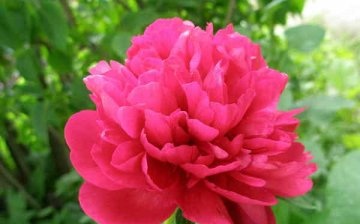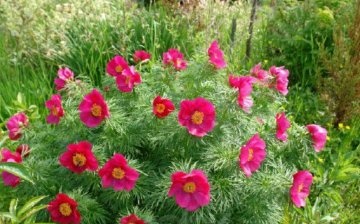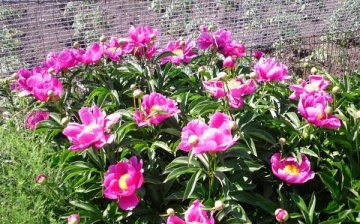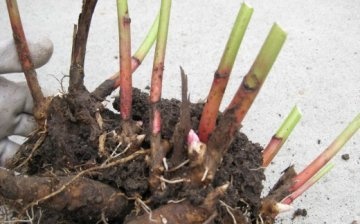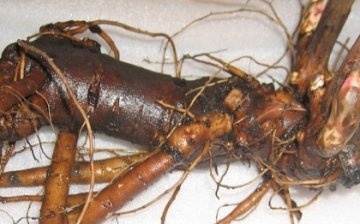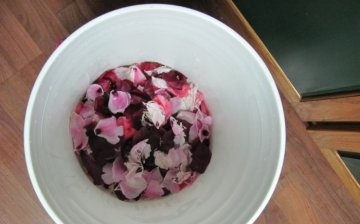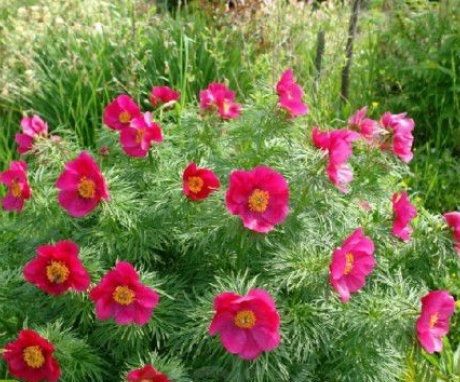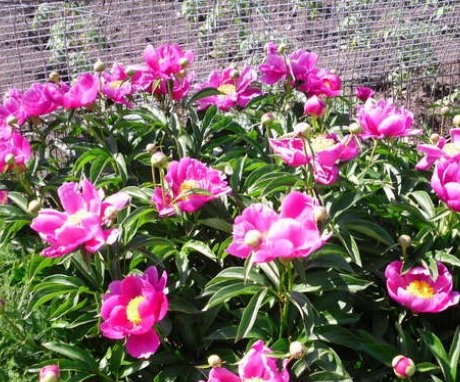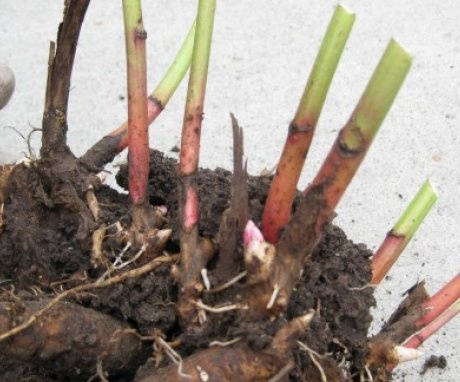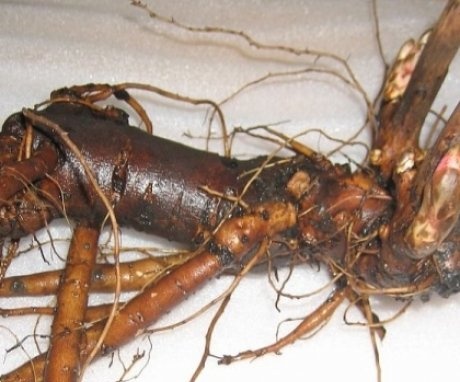Peony Maryin root: features of cultivation and application in medicine
Peony Maryin root has a second better known name - evading peony. The plant is herbaceous, reaches a height of no more than 1 meter, belongs to the Peony family.
Content:
- Description of the plant
- Growing a ducking peony in the garden
- Reproduction of the evading peony
- Procurement of raw materials
- Useful properties of peony Maryin root
Description of the plant
The plant is perennial, has large, powerful brown roots.
Peony dodging easily distinguish from other varieties:
- Its flowers are about 12 cm in diameter, pink-purple in color, they are located at the top of the stem.
- Peony leaves are alternate, complex shapes.
- The flowering period lasts from early May to late June, bears fruit in August.
- Reproduction can be carried out using seeds and vegetatively.
Peony Maryin root in some countries is listed in the Red Book, it is a rare, valuable plant.
In the wild, it can be found in Altai, in the Tien Shan mountains, East Asia and Southern Europe, in Russia it is found in the Perm Territory, Siberia and Komi.
Peony Maryin root grows on dry soils, easily tolerates cold, loves sunny places, but does not suffer in the shade. Much less often, a peony can be found in birch groves, taiga meadows, coniferous or deciduous forests.
In China, the duck peony has been cultivated for more than a millennium. For the Chinese, this is not just a plant, but a symbol of wealth and noble birth. The locals are convinced that the peony helps to get rid of dark spots on the skin and ward off nightmares. To overcome epilepsy, it was enough to wear this flower around the neck, and also to fumigate patients with smoke. Other legends circulated in Armenia. It was believed that the peony Maryin root is capable of expelling dark forces from a person. To cure gout and suffocation in Western Europe, a flower was applied to the heart.
In modern times, peony Maryin root continues to be used in folk medicine to treat many diseases, but this is not its only field of application.
In veterinary medicine, peony Maryin root is given to animals with gastrointestinal disorders. A decoction of the roots in a ratio of 1 to 100 helps to improve the appetite of animals and normalize the digestive processes, the acidity of the gastric juice increases, and the pain subsides. Helps in the treatment of stomach ulcers, liver, diarrhea, colic. In cooking, peony is used to prepare spices and drinks; in Mongolia, it is brewed as tea.
Growing a ducking peony in the garden
Peony Maryin root can grow at home... It has been successfully cultivated since the 18th century, so experienced gardeners will surely be able to share the secrets of care and reproduction. Like any other varieties of peony, evading peony can be grown for decorative purposes, it will perfectly complement any flower arrangement, but it can also be grown for medicinal purposes.
Peony Maryin root will not give a gardener a lot of trouble, it can be planted both in the sun and in the shade, it will look good and develop under decorative and fruit trees.
The flower is unpretentious to the soil, but it will grow best on loose fertile soils, moderately moist.
The most dangerous thing for an evading peony is an excess of watering and moisture, drafts. Thanks to the powerful rhizomes, all moisture accumulates in them, so a little watering will be enough.
Peony care features:
- Planting a peony the root marina is carried out in late August and early autumn, deepening the growth buds by no more than 5 cm, the flower must survive the winter without shelter.
- The first three years after planting a peony in the garden, you need to ensure that the soil is constantly loosened.
- Loosening is carried out during the entire growing season, when the first weeds appear, they must be removed immediately. Why is this so important? The harm of weeds is to draw out nutrients and water from the soil, disrupt the flow of air and contribute to the spread of diseases.
- After rain, you need to make sure that no crusts remain on the bud, loosening of young plants is carried out to a depth of 5 cm, and older plants by 15 cm.
- For mature plants, a slightly different care is needed. 3 years after planting, the plant needs pinching, one or two buds are left on the bush, the rest are removed, and flowers that have already faded are cut off. Thick bushes need props.
- When a plant is transplanted, it will bloom 2 or 3 years after the operation. Every year the peony blooms brighter and more abundantly. It is recommended to transplant a peony no more than once every three years.
Reproduction of the evading peony
Peony marin root reproduce in many ways:
- Seeds.
- By dividing the bush.
- By dividing the rhizomes.
- Stem cuttings.
- Layers.
The easiest way to propagate a peony is by dividing the rhizome. To do this, you need to choose middle-aged bushes and divide in such a way that there are 3 annual shoots on each separated bush, so half of the plants will bloom next year.
If reproduction is carried out by seeds, then they are sown closer to winter, and by spring the first shoots appear, but the first flowering will occur no earlier than 3 years later.
When planting shoots, a thick layer of manure is laid in the pits, about 20 cm, then a layer of 10 cm of compost, soil is poured on top with the addition of 40 grams of superphosphate and 90 grams of bone meal. Separated bushes must be mulched with peat.
Next, the standard peony care is carried out:
- Weeding.
- Loosening.
- Moderate watering.
- Periodic feeding.
How to grow a peony correctly:
- For the first time, top dressing is used in the spring, when the first shoots appear, 70 grams of nitroammophoska is applied under each bush.
- The fertilizer is spread over the diameter of the bush and sprinkled with soil, it can be mulched.
- Slow germination of seeds is associated with an underdeveloped embryo, but thanks to the seeds, a large number of bushes can be sown at once.
- Stratification should have 2 stages.
- First of all, the seeds should be in moist sand for 2 months at a temperature of about 25 degrees, and then the same amount at a temperature of 5 degrees.
- Now you can sow the seeds in a garden bed to a depth of 2-3 cm.
- When the active growing season begins, then it's time to add manganese and boron, that is, trace elements. The solution is made in the calculation: a few pinches of potassium permanganate and borax per bucket of water, the water should acquire a pinkish tint.
Until flowering has come for the peony, it will be useful to introduce mullein infusion with the addition of phosphorus or potassium fertilizer.
Already in September, the aboveground part of the bush is cut off, leaving up to 15 cm of shoot near the roots. Under each plant, you can add humus and mulch the bush.
Procurement of raw materials
Separately, the raw materials of the aboveground part of the peony and its roots are harvested, this is done at different times. The aboveground part is collected in July, during the flowering of the bush. The aerial part is carefully cut off with a knife, if it is torn off, the renewal buds can be damaged.
Roots for raw materials are harvested at any time of the year, but autumn is considered the most favorable period.As soon as the aerial part begins to fade, the largest amount of nutrients will be found in the roots.
The roots need to be well shaken off the ground and rinsed, they are left in a warm place for drying for several days, and then for fragility they are sent to the dryer, the temperature in which should not exceed 50 degrees. The roots will give off a pungent odor and taste sweet and astringent. To obtain the same amount of dry raw materials for each kilogram of raw roots, it is necessary to prepare 2 kg of raw aerial part.
When the raw material is prepared, you can compare it for compliance with the Pharmacopoeia Monograph:
- The length of the rhizomes and individual roots is from 1 to 9 cm.
- Thickness 21.5 cm.
- The color is yellow-brown or brown.
- When broken, the color of the root is light yellow.
- Sharp peculiar smell.
- Astringent sweet taste.
- The percentage of moisture in the raw material is 13.
- Ash percentage - 10.
- The percentage of short roots (up to 3cm) - 10.
- The percentage of impurities (pebbles, sand and earth) - 1.
- The dried aerial part consists of buds, flowers, leaves and stems.
Such raw materials can be stored for no more than 3 years, during this period it will have the most valuable properties.
Collect and use raw peony marin root should be taken with great care, since the flower is a poisonous species. The plant contains essential oils, which include salicylic and benzoic acids, resins and tannins, flavonoids, glycosides, as well as terpenoids, sitosterol and fatty oils.
As for its beneficial properties:
- That 1.6% in the plant is essential oil.
- Among biologically active substances are salicin glycoside, organic acids, glutamine, sugar, starch.
- The flowers contain a large amount of ascorbic acid, that is, vitamin C.
Useful properties of peony Maryin root
On the basis of the evading peony, a tincture is made, which helps to fight many diseases.
IN different time peony was used for various diseases, but today modern equipment and scientists were able to clearly indicate why the peony marin root is so useful:
- In traditional medicine, tincture of the plant is used, as well as in dry form or in the form of briquettes. Empirically determined the main properties of raw materials: anticonvulsant and sedative. At the same time, there is no negative impact on the functioning of the nervous system, heart and blood vessels.
- Officially, peony Maryin root is used in the treatment of vegetative-vascular diseases, sleep disorders, hysteria and hypochondria, neuroses. In rare cases, the plant is used to stimulate the secretion of gastric juice.
- In China, the peony began to be used in the fight against cancer, and before that in Mongolia it was considered a strong antidote. Until now, raw materials are used to fight tuberculosis, pneumonia and various kidney problems. The peony also has a positive effect in metabolic disorders. Some healers use the dodging peony to increase blood pressure.
- The infusion is drunk to normalize the condition and reduce the number of seizures in epilepsy, it copes with headaches, hemorrhoids, cervical erosion, malaria, gastrointestinal and liver diseases.
The plant has some contraindications. Firstly, it is necessary to observe the dosage and duration of the course due to the toxic composition, and secondly, it is forbidden to use the drug for pregnant women and children under 12 years of age. It is also not advisable to use peony Maryin root for hypotension and hyperacid gastritis, or do it under the supervision of a doctor.
Peony's active ingredients are similar to amidopyrine, which helps relieve inflammation.
Tincture from the roots and aerial part of the peony is used for insomnia, lethargy, vegetative-vascular dystonia, hypochondria, increased excitability. The tincture helps to improve performance, both physical and intellectual. To do this, it is enough to take 1 tsp. tinctures 3 times a day, the course lasts no more than a month.
More information can be found in the video.



